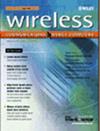Enhancing the Performance of 6LoWPAN-Based Wireless Sensor Networks (WSNs) with IEEE 802.11AH (Wi-Fi HaLow)
4区 计算机科学
Q3 Engineering
引用次数: 0
Abstract
6LoWPAN allows IEEE 802.15.4 standard-based wireless sensor networks (WSNs) to be connected to the Internet through the Internet protocol IPv6; however, its performance decreases as the network grows in size due to complications such as the bottleneck problem; therefore this paper aims to improve the performance of 6LoWPAN-based WSNs by using the IEEE 802.11AH standard as a backbone in these networks, since this emerging new technology is suitable for IoT applications, as it can provide a coverage range up to 1,000 m and data transmission rates up to 78 Mbps. The IEEE 802.11AH standard can be used as a backbone by utilizing its characteristics to improve some of the performance parameters of the 6LoWPAN networks such as end-to-end delay, frames delivery ratio, and the network throughput. This paper proposes a heterogeneous network infrastructure consisting of 6LoWPAN and the IEEE 802.11AH standard to enable bidirectional data transmission between the network components and the Internet via the Internet protocol IPv6 with two types of gateways, the edge gateways to connect the entire network to the Internet and the intermediate gateways to connect the 6LoWPAN clusters to the edge gateways. The simulation results demonstrate that the heterogeneous network approach can provide significant improvement gains compared to the 6LoWPAN homogeneous networks, since it shows clear improvements to the packets delivery ratio, the end-to-end delay mean value and the network throughput, subsequently leading to a distinct enhancement in the network’s overall reliability.基于IEEE 802.11AH (Wi-Fi HaLow)的6lowpan无线传感器网络(WSNs)的性能提升
6LoWPAN允许基于IEEE 802.15.4标准的无线传感器网络(wsn)通过互联网协议IPv6连接到互联网;然而,由于瓶颈问题等复杂问题,它的性能随着网络规模的增长而下降;因此,本文旨在通过在这些网络中使用IEEE 802.11AH标准作为骨干来提高基于6lowpan的wsn的性能,因为这种新兴的新技术适用于物联网应用,因为它可以提供高达1,000 m的覆盖范围和高达78 Mbps的数据传输速率。IEEE 802.11AH标准可以利用其特性来改善6LoWPAN网络的一些性能参数,如端到端延迟、帧传送率和网络吞吐量,从而作为骨干网络使用。本文提出了一种由6LoWPAN和IEEE 802.11AH标准组成的异构网络基础设施,通过互联网协议IPv6实现网络组件与互联网之间的双向数据传输,并采用两种网关,即连接整个网络与互联网的边缘网关和连接6LoWPAN集群与边缘网关的中间网关。仿真结果表明,与6LoWPAN同构网络相比,异构网络方法可以提供显着的改进增益,因为它在数据包传送率,端到端延迟平均值和网络吞吐量方面显示出明显的改进,从而导致网络整体可靠性的明显增强。
本文章由计算机程序翻译,如有差异,请以英文原文为准。
求助全文
约1分钟内获得全文
求助全文
来源期刊
自引率
0.00%
发文量
2475
审稿时长
9.9 months
期刊介绍:
Presenting comprehensive coverage of this fast moving field, Wireless Communications and Mobile Computing provides the R&D communities working in academia and the telecommunications and networking industries with a forum for sharing research and ideas.
The convergence of wireless communications and mobile computing is bringing together two areas of immense growth and innovation. This is reflected throughout the journal by strongly focusing on new trends, developments, emerging technologies and new industrial standards.

 求助内容:
求助内容: 应助结果提醒方式:
应助结果提醒方式:


